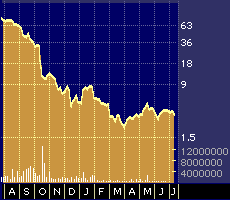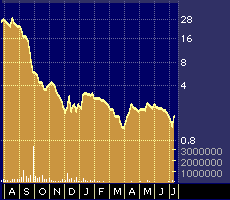
Future Bright for Young DSL Companies
Future Bright for Young DSL Companies
by Hal Plotkin
Silicon Valley Correspondent
.
Trend-spotting analysts say there is a huge opportunity for a handful of newer companies making higher bandwidth, digital-subscriber line (DSL) Internet connections available to a greater numbers of consumers.
“There are still a lot of people who are stuck with analog modems,” says Kathie Hackler, principal analyst at Dataquest, based in San Jose, Calif. “Many of them want something faster. DSL services are often very attractive to them.”
These companies include IPO-bound GoDigital Networks Corp., based in Fremont, Calif., and two recently public companies: Copper Mountain Networks {CMTN}, based in Palo Alto, Calif., and Paradyne Corp. {PDYN}, based in Largo, Fla.,

Copper Mountain Networks post-IPO stock performance
Copper Mountain went public last May with shares initially priced at $21.
In October, Copper Mountain reported net income of $4.6 million, on revenue of $32 million, as compared with a loss of $3.3 million on revenue of $5.6 million for the same period a year earlier. The company’s products enable telecommunications companies and Internet service providers to offer up to 16 DSL lines over a single copper phone line.
Copper Mountain has benefited from a number of significant customer wins over the past quarter, including sales to 14 new carrier-class customers. The company is the largest pure-play DSL equipment supplier for business users, according to a recent report from Dataquest.

Paradyne post-IPO stock performance
Paradyne, another leading DSL equipment maker, went public on July 15, with shares initially priced at $17. On Oct. 4, Paradyne completed a secondary public offering of 5 million shares of stock at $31 a share.
Paradyne’s products also increase the number of DSL lines that can be offered on a single copper wire and make it possible to serve consumers located at geographic distances previously out of reach. The company has several strong marketing partnerships, including a key deal with Lucent Technologies Inc. {LU}.
Paradyne’s sales didn’t grow as quickly as Copper Mountain’s over the last quarter on record. On Oct. 27, the company reported third-quarter net income of $1.8 million on revenue of $57.8 million, compared with a loss of $339,000, on revenue of $51.3 million for the same period last year.
In mid-December, however, Paradyne’s new Hotwire MVL (multiple virtual lines) technology was officially deemed compatible for line sharing by the Federal Communications Commission, a development that opens up additional opportunities for the company.
“One of the great things about this market is that it’s really a horse race,” says Gary Kim, an analyst at NxGen, a Chicago-based research company that tracks the DSL market. “At some point in time, data services will be as important as basic telephone service is today. And it’s an entirely new opportunity. You don’t have to steal somebody’s else’s customer to take a huge share of the market.”
The pending initial public offering of GoDigital Network will give investors another chance to bet on the burgeoning market for DSL equipment.
GoDigital reported a loss of $4.6 million, on revenue of $11.7 million for the six months ended Sept. 30, as compared with a loss of $2.8 million on slightly more than $1 million in sales for the same period a year earlier.
GoDigital’s products extend the reach of DSL services up to 25 miles from a phone-company facility, five times further than competing technologies, though at speeds that are only slightly higher than integrated services digital network (ISDN) lines.
“I don’t think that technology is going to go anywhere,” says Frank Dzubeck, president of Communications Network Architects, an industry analysis firm based in Washington. “It’s such a small increase in line speed over ISDN, and it takes carriers a year or more to test and roll out the service. I don’t see that it adds very much.”
But Brownlee Thomas, senior analyst at the Giga Information Group, based in Montreal, disagrees. “The advantage is that it makes it possible to bring higher bandwidth service to areas not served by ISDN,” she says. “That could help companies offer something in place of nothing, get market share and then increase the speeds for a large base of installed users as the technology improves.”
Thomas says GoDigital’s fate over the long term will be determined by factors not now known, such as whether it is easy and inexpensive to increase the speeds offered to end users as refinements are made in DSL data-transmission techniques.
One thing analysts do agree on, however, is that the future looks bright for DSL equipment makers. But they’re not entirely in agreement on how bright.
According to Dataquest, for example, sales of DSL equipment are projected to grow at a compound annual rate of 64 percent between 1999 and 2003, while sales of cable modems, by contrast, are projected to grow at a slower but still respectable compound annual rate of 44 percent over the same period.
“DSL is starting to catch cable, and I think it will catch it this year,” Hackler says.
Giga Information Group, however, which is also based in San Jose, Calif., sees the numbers differently, estimating that cable consumers will outnumber DSL consumers four to one by 2003.
“Cable has a very high viability,” says Lisa Pierce, director of telecom services analysis at Giga Information Group. “We’re starting to see cable users disconnecting from their local phone companies. That is obviously what the cable operators want to see.”
Cable-modem service currently has a commanding lead in the race to bring high-speed Internet access to U.S. homes. By year-end 1999, an estimated 1.3 million of U.S. homes had high-speed cable access, about five times more than the number of DSL subscribers, according to International Data Corp., based in San Jose, Calif. Wireless operators, by contrast, have yet to make serious inroads into the high-speed Internet-access market.
“People argue about the numbers, but DSL definitely has a future,” says Mark Zohar, senior analyst at Forrester Research, based in Cambridge, Mass.
Zohar notes that there are also unique security concerns associated with cable-data services, which operate over a shared local network. “Copper phone lines are ubiquitous, are capable of multi-megabit bandwidth and don’t have some of the problems cable has,” he adds.
Last week’s announcement that Newport Beach, Calif., start-up Broadband Digital Group would begin offering free DSL services to consumers willing to watch advertising, further verifies analyst projections of booming demand for DSL equipment.
“It’s only a matter of time,” Hackler says. “DSL has been around for a long time, but the whole ball game is changing now. For the first time, the local phone companies are facing really serious competition from cable firms. So it’s become a competitive issue for them. They can’t drag their feet deploying DSL anymore, or they’re going to lose customers.”


